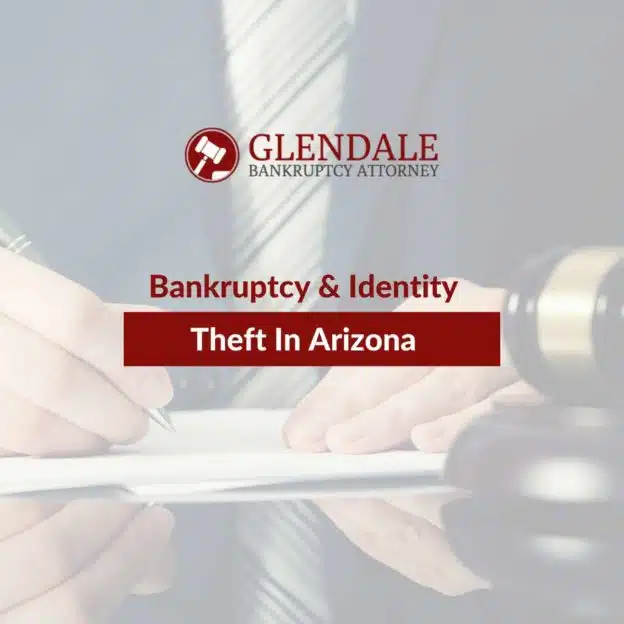Bankruptcy & Identity Theft In Arizona
There are countless driving forces behind bankruptcy in Arizona and the United States as a whole. Medical emergencies are the leading cause of bankruptcy, but other life events like job loss, divorce, or just simple poor budgeting can create debts that can’t be resolved without assistance from a legal process such as bankruptcy. Sometimes debt can stem from the criminal activity of others, such as identity theft. Additionally, an identity thief can steal someone’s personal information and use it to file for bankruptcy in their name. Bankruptcy and identity theft are two complex issues when separate, but it makes things even more complicated when they’re combined. If you have questions or concerns about the intersection of identity theft and filing for bankruptcy in Glendale or Avondale, Arizona, call 623-640-4945 for your free consultation with our firm. You may even qualify to file using our firm’s Zero Down payment plan option.

More Information About Identity Theft
Identity theft occurs when one person uses another person’s personal or financial information without their permission. Arizona ranked 6th in the nation for fraud in 2023. There were 1,206 reports of identity theft per 100,000 population, with a total of 86,066 reports. However, it ranked 16th for identity theft in particular, with a total of 18,539 reports. The most common type of identity theft in the United States is through credit cards. Some examples of fraud categories include:
- Imposter scams- Ex: A scammer calls an elderly person pretending to be their grandchild, saying they were arrested while on a foreign vacation and desperately need money wired to them or they will be incarcerated abroad.
- Prizes, sweepstakes, and lotteries- Ex:
- Business and job opportunities- Ex: An identity thief makes a false job posting for a remote position and convinces an applicant to submit their social security number with their application. Then they use that information to open up credit cards in the applicant’s name.
- Online shopping and negative reviews- Ex:
- Investments- Ex: An identity theft victim willingly sends money to invest in a false product that the thief has no intention of producing. Identity theft victims from this category report the highest median loss at $7,768 per incident.
Shouldn’t Identity Theft Debts Be Removed?
Someone who believes they have been the victim of identity theft is encouraged to report the identity theft to the Federal Trade Commission, or FTC, and the three main credit reporting bureaus as soon as possible. The victim’s credit can be frozen, which sets forth an identity verification requirement before any new debts can be incurred under the victim’s name. It should also be reported to the fraud department at any company at which a fraudulent debt is charged. Usually, this is sufficient to have a fraudulent charge removed from the victim’s credit. However, sometimes the process of proving fraud to these agencies doesn’t go smoothly. A common example of this is when the identity thief is tracked down, it turns out to be someone the victim knows or is related to, and the victim doesn’t want to press charges. Sometimes, the company at which the debt is charged simply isn’t cooperative with removing the debt. Either way, this can leave the victim with the burden of debt that they didn’t spend or approve. If this is combined with debts that the victim did actually intend to incur, their monthly payments, interest, late fees, etc., may begin to exceed their budget. This might create the need for the identity theft victim to seek debt relief.
What Happens to Identity Theft Debt in Bankruptcy
If an identity theft victim can’t get their debts removed or are otherwise deemed liable for them, bankruptcy may be an option to discharge them. As mentioned above, the most common type of debt incurred from identity theft is credit card debt. The good news is that credit card debt is unsecured non-priority debt, which makes it eligible for discharge in bankruptcy. Some unsecured debts, like child support and taxes that don’t meet certain requirements, can’t be wiped away by a bankruptcy filing and must be paid. Unsecured non-priority debts are erased in chapter 7 bankruptcy, which is the most popular form of consumer bankruptcy. Unsecured non-priority debts are only paid to the extent that the debtor can afford in chapter 13 bankruptcy, which is a payment plan bankruptcy that is used by debtors with higher incomes or debts that can’t be discharged in chapter 7.
Some bankruptcy debtors can choose which chapter to file, but many will only qualify for one or the other. Qualifying for bankruptcy can be a tricky subject. In chapter 7 bankruptcy, the debtor must prove that they don’t have enough income to pay off their debts, but in chapter 13 bankruptcy, the debtor must prove that they do have enough income to pay off their debts over time. The first step to both of these is calculating the debtor’s average income. Some people are salaried employees, while others may own their own business or have a variable income. Regardless, the court will look back at the debtor’s income for the past 6 months.
The potential bankruptcy debtor can compare their average monthly income to the median monthly income for households of their size in their state. If their income falls below the median, they will qualify for chapter 7 and have a 3-year payment plan if they file for chapter 13. If their income is above the state median, they will need to use the means test to qualify for chapter 7 and they will have a 5-year payment plan if they file for chapter 13. The means test is also used to determine how much a chapter 13 debtor will pay into their plan.
To conduct the means test, the debtor must subtract certain allowable expenses from their average monthly income. The expenses should be reasonable and necessary, such as a home mortgage or rent, groceries, utilities, student loans, child support, etc. Vacations, meals at restaurants, clothes shopping beyond what is necessary, and other luxuries can’t be used on the means test. When the results of the means test fall below a certain threshold, the debtor can file for chapter 7 bankruptcy. To qualify for chapter 13 bankruptcy, that number must be enough for the debtor to pay off mandatory debts like secured debts and priority debts over their payment plan’s lifespan. If you have more questions about qualifying for bankruptcy in Glendale or Avondale, Arizona, call 623-640-4945 for your free consultation with our firm.
Experienced Arizona Bankruptcy Lawyers Offering Zero Down Payment Options
If you are seeking debt relief after identity theft in Avondale or Glendale, our firm may be able to assist. Many of our clients are eligible to file for bankruptcy and protect themselves from creditors using our Zero Down payment plan option. Take charge of your financial situation and create opportunities to rebuild your credit in the future. Glendale Bankruptcy Lawyers will make each step of the process easier, which begins with your free consultation by phone. To take the first step towards filing for bankruptcy and wiping your slate clean, call 623-640-4945 to schedule your free consultation.


